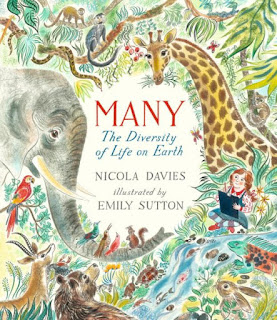I'm really torn about this book, but it's overdue at the library I borrowed it from, so I have to make up my mind!
With simple text but lyrical text, Davies explains the concept of biodiversity. The story begins with one cockroach, then adds a girl, then a bush, and then there are many things in the facing spread. Davies examines elephants and seashells, species identification and classification, food cycles and slight differences in species. This section of the story closes with a rich jungle scene, teaming with life.
The last five spreads strike sobering note in this exploration. Davies explains that biodiversity is shrinking, due to pollution, the destruction of habitats, and other human activities. We see the same jungle scene, this time with fallen trees and only a few living things left. There is a view of a museum exhibit of extinct animals and an opposing view of creatures that still exist, although many are endangered. The final spread shows a last scene with the same opening variety of animals faced by a page that shows only the girl. The text reads, "because we could not keep living on earth if we had to count down instead of up.../from MANY to one."
I like Davies' text, but I truly love Sutton's illustrations. Beginning with elaborate endpapers featuring a wide variety of green pen drawings of various flora and fauna, and moving into the increasingly involved art, Sutton shows the intrepid, red-haired explorer venturing beneath the sea, into the jungle, to hot springs and reefs, the Galapagos and deserts. Along the way we see a huge variety of animals, plants, microbes, bugs, and many other forms of life.
One thing, however, gives me pause. This picture book is directed at one children, but the ending felt very dark to me. I'm not particularly a fan of sugar-coating realities for kids, but I also believe in presenting them with some kind of hope and assurance. The problems shown are far too big for a child to even contemplate solving and that final sentence is frighteningly dark.
Verdict: Every child will react differently to this, but it's one I'd include as part of a unit, with an adult to discuss, not one I'd hand a child alone to read. I do really love the illustrations though.
ISBN: 9780763694838; Published November 2017 by Candlewick; Borrowed from another library
With simple text but lyrical text, Davies explains the concept of biodiversity. The story begins with one cockroach, then adds a girl, then a bush, and then there are many things in the facing spread. Davies examines elephants and seashells, species identification and classification, food cycles and slight differences in species. This section of the story closes with a rich jungle scene, teaming with life.
The last five spreads strike sobering note in this exploration. Davies explains that biodiversity is shrinking, due to pollution, the destruction of habitats, and other human activities. We see the same jungle scene, this time with fallen trees and only a few living things left. There is a view of a museum exhibit of extinct animals and an opposing view of creatures that still exist, although many are endangered. The final spread shows a last scene with the same opening variety of animals faced by a page that shows only the girl. The text reads, "because we could not keep living on earth if we had to count down instead of up.../from MANY to one."
I like Davies' text, but I truly love Sutton's illustrations. Beginning with elaborate endpapers featuring a wide variety of green pen drawings of various flora and fauna, and moving into the increasingly involved art, Sutton shows the intrepid, red-haired explorer venturing beneath the sea, into the jungle, to hot springs and reefs, the Galapagos and deserts. Along the way we see a huge variety of animals, plants, microbes, bugs, and many other forms of life.
One thing, however, gives me pause. This picture book is directed at one children, but the ending felt very dark to me. I'm not particularly a fan of sugar-coating realities for kids, but I also believe in presenting them with some kind of hope and assurance. The problems shown are far too big for a child to even contemplate solving and that final sentence is frighteningly dark.
Verdict: Every child will react differently to this, but it's one I'd include as part of a unit, with an adult to discuss, not one I'd hand a child alone to read. I do really love the illustrations though.
ISBN: 9780763694838; Published November 2017 by Candlewick; Borrowed from another library

No comments:
Post a Comment